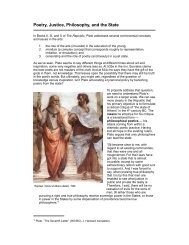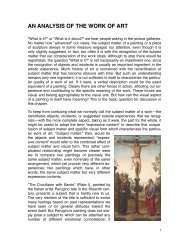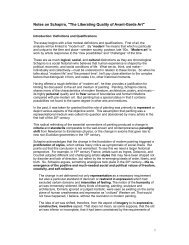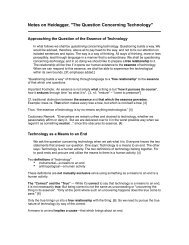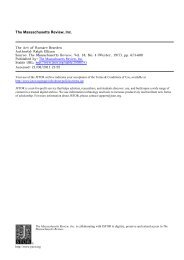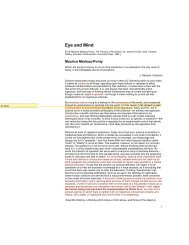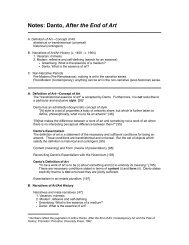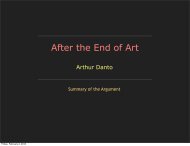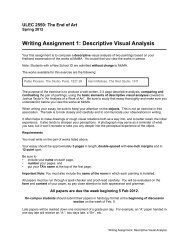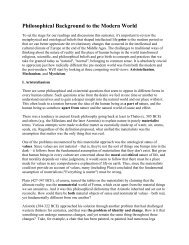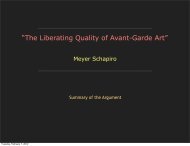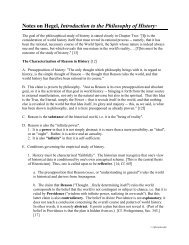Aesthetics: Perception, Subjectivity, and Embodiment - Timothy R ...
Aesthetics: Perception, Subjectivity, and Embodiment - Timothy R ...
Aesthetics: Perception, Subjectivity, and Embodiment - Timothy R ...
Create successful ePaper yourself
Turn your PDF publications into a flip-book with our unique Google optimized e-Paper software.
<strong>Aesthetics</strong>: <strong>Perception</strong>, <strong>Subjectivity</strong>, <strong>and</strong> <strong>Embodiment</strong>Fall 2009Course DescriptionThis course examines modern <strong>and</strong> contemporary theories of artistic <strong>and</strong> aesthetic experience.We start with the question of taste. Are there st<strong>and</strong>ards we can use to determine thata work of art, literature, or music is good? Or is quality simply a matter of personal preference?We examine in detail Immanuel Kant's revolutionary attempt to show that aestheticjudgments are both subjective <strong>and</strong> universal. Then we look at three later developments --Martin Heidegger's ontological approach to art, Maurice Merleau-Ponty's emphasis on one'sbodily engagement with art, <strong>and</strong> Gilles Deleuze's "logic of sensation" applied to the work ofFrancis Bacon.Throughout the semester we consider how these insights <strong>and</strong> theories apply to a culturallydiverse set of works. This course will be of interest to serious students of philosophy, literature,visual <strong>and</strong> media studies, music, <strong>and</strong> art criticism.Instructor: <strong>Timothy</strong> QuigleyThe New School66 West 12th StreetNew York, NY 10011 USAVoice: 212 229 5119Fax: 212 229 2588Email: quigleyt@newschool.eduWebsite: http://homepage.newschool.edu/~quigleytRequirements for Credit StudentsThere will be weekly reading <strong>and</strong> in-class discussions, as well as occasional short writing assignments[20% of the final grade], a descriptive analysis (7-8 pages) <strong>and</strong> final critical essay(10-12 pages) [40% each].Each of you will be evaluated on the basis of your own achievement—you are not competingwith one another for grades. If everyone gains proficiency with the material, you'll allend up with As. So work together, help one another as much as you can, <strong>and</strong> don't hesitateto ask me for help when you need it.Since class discussions are meant to be collaborative <strong>and</strong> thoughtful, thorough preparation isessential. Writing brief summaries <strong>and</strong> formulating questions about the issues discussed inthe text will help you formulate an underst<strong>and</strong>ing <strong>and</strong> to clarify <strong>and</strong> refine your own views.You may want to keep a journal for your notes <strong>and</strong> reflections.Required Texts• Immanuel Kant, Critique of Judgment, trans. Werner S. Pluhar, Indianapolis: Hackett, 1987.• Gilles Deleuze, Francis Bacon: The Logic of Sensation, trans. Daniel W. Smith, Minneapolis:University of Minnesota Press, 2004.• Course PacketNote: There are several versions of Kant’s text in English. Be sure to get the Pluhar translation.<strong>Aesthetics</strong> - Syllabus, Fall 2009 1
Weekly Schedule of Readings <strong>and</strong> Discussion TopicsAdditional materials such as study questions, h<strong>and</strong>outs, course packet <strong>and</strong> supplementary readings,etc. will be made available online athttp://homepage.newschool.edu/~quigleyt/aesthetics/syllabus.htmlSession 1: 31 Aug 09Introduction7 Sep 09 — ** Labor day, No Class Session **Session 2: 14 Sep 09<strong>Timothy</strong> Quigley, Background <strong>and</strong> Introduction to Kant’s Third Critique<strong>Timothy</strong> Quigley, "Eighteenth Century European Philosophy: Inner Sense Theories"Jens Kuhlenkampff, “The Objectivity of Taste: Hume <strong>and</strong> Kant”Session 3: 21 Sep 09Immanuel Kant, Critique of Judgment, “Critique of Aesthetic Judgment, Book I. Analytic ofthe Beautiful” [43-60]Descriptive Analysis - Option 1: First Moment of the Judgment of TasteDescriptive Analysis - Option 2: Second Moment of the Judgment of Taste28 Sep 09 — No Class Meeting (Rosh Hashana) — Class Meets on TuesdaySession 4: 29 Sep 09 (Tuesday)Immanuel Kant, Critique of Judgment, “Critique of Aesthetic Judgment, Book I. Analytic ofthe Beautiful” [61-95]Descriptive Analysis - Option 3: Third Moment of the Judgment of TasteDescriptive Analysis - Option 4: Fourth Moment of the Judgment of TasteSession 5: 5 Oct 09Immanuel Kant, Critique of Judgment, “Critique of Aesthetic Judgment, Book II. Analyticof the Sublime” [97-140]Descriptive Analysis - Option 5: The Mathematically SublimeDescriptive Analysis - Option 6: The Dynamically SublimeSession 6: 12 Oct 09Immanuel Kant, Critique of Judgment, “Deduction of Pure Aesthetic Judgments” [141-170]Session 7: 19 Oct 09Immanuel Kant, Critique of Judgment, “Deduction of Pure Aesthetic Judgments” [170-230]Descriptive Analysis - Option 7: Fine Art <strong>and</strong> GeniusSession 8: 26 Oct 09Martin Heidegger, "Origin of the Work of Art" [PDF]Session 9: 2 Nov 09Martin Heidegger, "Origin of the Work of Art" [PDF]<strong>Aesthetics</strong> - Syllabus, Fall 2009 2
Session 10: 9 Nov 09Maurice Merleau-Ponty, "Eye <strong>and</strong> Mind" [PDF]Session 11: 15 Nov 09Maurice Merleau-Ponty, "Eye <strong>and</strong> Mind" [PDF]Session 12: 23 Nov 09Gilles Deleuze, Francis Bacon [vii-xxxiii; 3-38]Session 13: 30 Nov 09Gilles Deleuze, Francis Bacon [39-98]Session 14: 7 Dec 09Gilles Deleuze, Francis Bacon [99-129]Session 15: 14 Dec 09SummaryPreparation for Class Discussions1. Read every selection at least twice.a. Read each selection once through quickly to get the main points of the text <strong>and</strong> tobetter appreciate how the author approaches the subject.b. Read each selection a second time to examine very carefully the details <strong>and</strong> structureof the argument.2. Be sympathetic, but critical. Often you may feel put off by an author's language, point ofview, critical approach, etc. When this happens, it's always a good idea to try to see itfrom the author's point of view. Then, when you underst<strong>and</strong> why someone would write insuch a way or adopt such a view, you'll be in a better position not only to underst<strong>and</strong> itbut to critically evaluate it.3. Take notes <strong>and</strong> look up unfamiliar words.4. Read analytically by asking the following questions:a. What is the central idea, thesis, objective or function of this text?b. Which statements, examples, or strategies in the text support this objective? Is thereanything about the text that undermines what you have identified as "the central objective"?c. What are the key terms <strong>and</strong> how are they defined?d. What assumptions does the text make? (These may often be unstated or hidden assumptions,so you may have to "read between the lines" to find them.)e. What are some of the important implications of the position taken in the text?5. In cases where you disagree with the text, articulate clearly what you disagree with <strong>and</strong>what reasons support your own view.This analysis, together with your questions <strong>and</strong> responses to the readings, will form the basisof our weekly class discussions.Students with DisabilitiesIn keeping with the University's policy of providing equal access for students with disabilities,any student with a disability who needs academic accommodations should contact the office<strong>Aesthetics</strong> - Syllabus, Fall 2009 3
of Student Disability Services. All conversations will be kept confidential. Students requestingany accommodations will also need to meet with Tom McDonald in the office of StudentDisability Services, who will conduct an interview, <strong>and</strong> if appropriate, provide an academicaccommodation notification letter. Mr. McDonald's office is 65 Fifth Avenue, Room 409. Hecan be reached by phone at 212 229 5472. More information through Student Services <strong>and</strong>on the University website.Statement on Academic HonestyIt is expected that all work submitted for a grade in this course reflects the work of the studentsubmitting it. Students are encouraged to discuss their work with others (inside <strong>and</strong> outsideof class), <strong>and</strong> to exchange information, comments, <strong>and</strong> criticisms. But keep in mind that if youborrow an idea from someone else, you must cite the source, even if it is based on a conversationor correspondence.Plagiarism or any other form of academic dishonesty will result in a failing grade for the assignmentfor the first offense. A subsequent offense will result in a failing grade for thecourse. All instances of academic dishonesty are reported to the Deans' office for review.Any student who does not fully underst<strong>and</strong> the st<strong>and</strong>ards of academic honesty should speakto me in advance of submitting coursework.<strong>Aesthetics</strong> - Syllabus, Fall 2009 4



